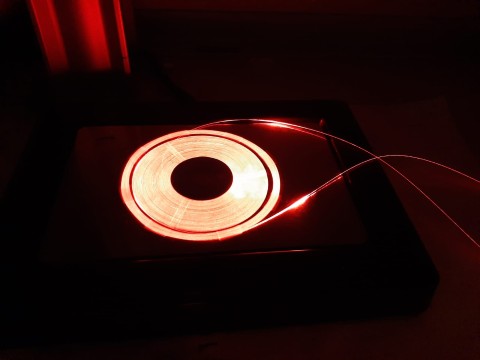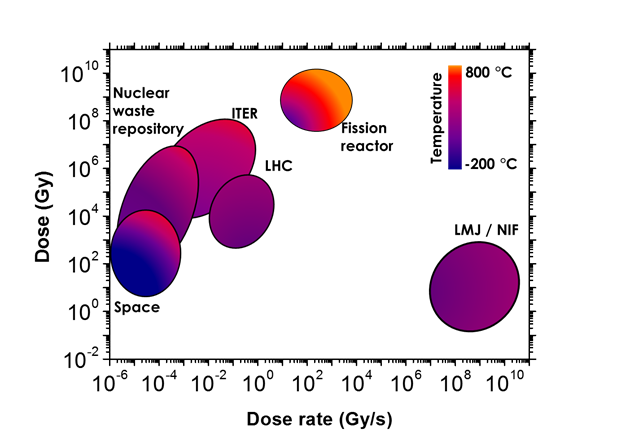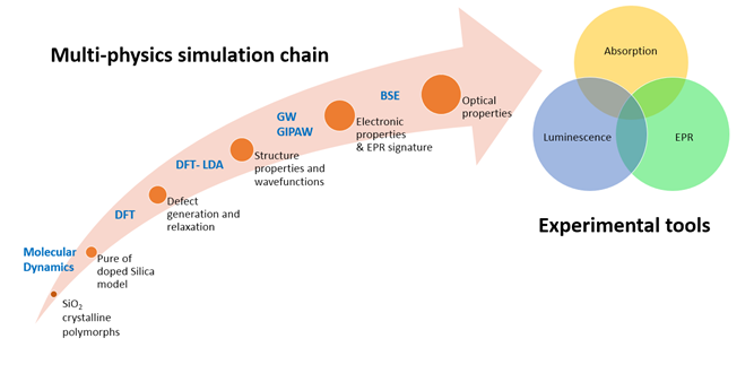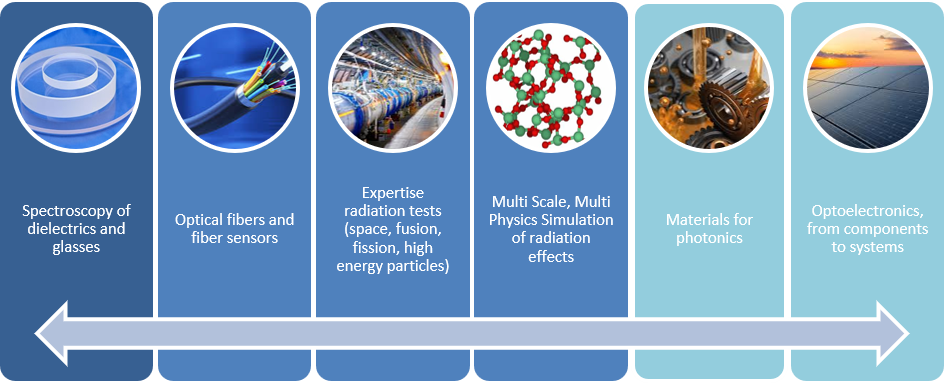MOPERE teamMaterials for Optics and Photonics in Extreme Radiation Environments

Credits: Cosimo Campanella
General presentation
The MOPERE team specializes in the study of the response of optical materials, components and photonic systems subjected to harsh environments and in particular radiation environments. In 2025, its main research topics are:
- Study of the basic mechanisms of generation and bleaching of radiation-induced point defects, structural and optical properties of point defects in glasses;
- Optical fibers and fiber-based sensors for harsh environments;
- Evaluation of the vulnerability and hardening of photonic technologies, optical materials and materials for photonic systems;
- Study and development of optical systems and cameras for harsh environments;
- Development of innovative optical solutions for dosimetry and beam instrumentation;
- Pump-probe experiments to reveal the absorption/luminescence photocycles occurring on femtoseconde-picoseconde scale in different optical materials.
Since 2000, MOPERE has specialized in the assessment of the vulnerability and radiation hardening of fiber optic technologies to new radiation environments such as those illustrated below (see our recent review papers #1, #2 and #3 on this topic). Its studies cover from the fundamental aspects on this theme to applications and are based on a strong collaborative network, in particular a very strong collaboration with the French industrial Exail, characterized by the creation of a joint laboratory: the LabH6.

Beyond the simple characterization of the response of silica-based optical fibers and point or distributed fiber optic sensors under irradiation, the group has specialized in understanding the basic mechanisms behind the macroscopic degradation of these components and develops numerous spectroscopic studies (absorption, luminescence, Raman, cathodoluminescence ...) for the identification of microscopic defects responsible for the degradation of optical and structural properties of fibers. Thanks to the knowledge acquired in collaboration with its historical partners (CEA DAM, University of Nova Gorica, University of Palermo, CNR Trieste; ORANO; ANDRA), MOPERE has developed the multi-scale, multi-physical approach illustrated below allowing to overcome the limitations of a purely experimental approach. The acquired knowledge, reviewed in 2019 [#3] is then used to control the generation of these defects, either in order to realize radiation-hardened materials and components, or on the contrary to exacerbate their sensitivity in order to realize radiation detectors or dosimeters. Part of this LabH6 research on radiation detection with optical fibers is done in close collaboration with CERN and CNES.

Group expertise
The main objective of MOPERE is to offer innovative solutions to our partners through the understanding of the basic mechanisms of radiation effects in optical material, optical devices and systems. The main competences of the MOPERE team members are summarized in the figure below:

Logistics
MOPERE operates today three X-ray irradiation machines, part of the PETRA platform: MOPERIX (160 kV) and LabHX (220 kV) allowing to irradiate and characterize in situ the radiation responses of samples at various dose rates from 500 µGy(SiO2)/s up to 60 Gy/s and different temperatures of irradiation (-100°C - 400°C).
MOPERE has access to various spectroscopic tools (pump-probe experiments, confocal microscope, time-resolved luminescence, absorption spectrophotometer, cathodoluminescence) allowing to characterize the structural and optical properties of point defects in glasses.
MOPERE is specialized in the manufacturing of Fiber Bragg Gratings (FBGs) through a variety of inscription techniques: UV laser, femtosecond type I or Type II FBG, regenerated FBGs …
MOPERE has access to a variety of fiber-based sensing techniques such as OTDR, OFDR, RDTS, BOTDA, BOTDR as well as the needed resources for the calibration of point or distributed sensors.
